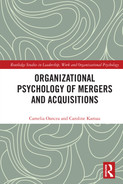Organizational Psychology of Mergers and Acquisitions provides a comprehensive perspective that helps you understand, empathise and protect the wellbeing of employees who experience mergers and acquisitions. This book gives a state-of-the-art review that crosses different subjects within psychology including psychobiology, neuroscience, social psychology, interpersonal relationships, and organizational psychology. This book discusses why many employees think of mergers or acquisitions as scary or threatening events, why negative emotions are prevalent, their psychobiological impact and how to assess employees’ emotional responses using a new toolkit. It helps readers learn what counts as good leadership, considering the role of charisma, personality, context and information processing abilities. This book includes the issue of organizational learning, and the relevance of occupational health and safety to due diligence about mergers and acquisitions through case studies about organizations sued for cancer or cancer-related mortality after a merger or acquisition. This book is mandatory reading for students, academics, and practitioners working with organizations experiencing a merger or an acquisition such as consultants, human resource professionals, psychologists, occupational health professionals, and employees involved in strategy, management, or people development.
Table of Contents
- Cover
- Half Title
- Series
- Title
- Copyright
- Contents
- List of figures
- List of tables
- Preface
- 1 Understanding and classifying different types of mergers and acquisitions
- 2 Historical trends in mergers and acquisitions, and why employees think of them as scary events involving job losses and other negative outcomes
- 3 Psychobiology of human emotions, why employees experiencing mergers or acquisitions feel fear, anger, and other negative emotions, and a new assessment toolkit
- 4 What makes employees support or resist a merger or acquisition, and what makes them want to quit?
- 5 Why employees experiencing mergers and acquisitions think and act in terms of group dynamics of “us versus them”
- 6 Why cultural differences in nonverbal language and workplace interactions create problems among employees experiencing mergers and acquisitions
- 7 Good leadership in mergers or acquisitions is about charisma, dynamics with employees, personality, context, and information processing
- 8 Organizational learning is a common goal in mergers and acquisitions, but what psychological processes help or hinder it?
- 9 Considering occupational health and safety in due diligence for mergers and acquisitions – learning from lawsuits about cancer mortality
- References
- Index
